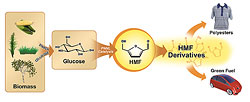Plastic that Grows on Trees, Part Two
One-step process derives raw material for fuels and plastic from plants rather than crude oil
(June 2009)

Scientists at Pacific Northwest National Laboratory have discovered the most effective method yet to convert glucose, found in plants worldwide and nature's most abundant sugar, to HMF, a chemical that can be broken into components for products now made from petroleum. Enlarge Image.
Some researchers hope to turn plants into a renewable, nonpolluting replacement for crude oil. To achieve this, scientists have to learn how to convert plant biomass into a building block for plastics and fuels cheaply and efficiently. In new research, chemists have successfully converted cellulose—the most common plant carbohydrate—directly into the building block called HMF in one step.
The result builds upon earlier work by researchers at Pacific Northwest National Laboratory. In that work, scientists produced HMF from simple sugars derived from cellulose. In this new work, researchers developed a way to bypass the sugar-forming step and go straight from cellulose to HMF. This simple process generates a high yield of HMF and allows the use of raw cellulose feed material, the researchers report in an upcoming issue of Applied Catalysis A.
"In biomass like wood, corn stover and switchgrass, cellulose is the most abundant polymer that researchers are trying to convert to biofuels and plastics," said chemist Z. Conrad Zhang, who led the work while at PNNL's Institute for Integrated Catalysis.
HMF, also known as 5-hydroxymethylfurfural, can be used as a building block for plastics and "biofuels" such as gasoline and diesel, essentially the same fuels processed from crude oil. In previous work, PNNL researchers used a chromium chloride and an ionic liquid to convert the simple sugars into HMF.
The chromium chloride converted sugar into highly pure HMF. But to be able to feed cellulosic biomass directly from nature, the team still needed to break down cellulose into simple sugars—Zhang and colleagues wanted to learn how to skip that step.
The ionic liquid has the added benefit of being able to dissolve cellulose, which as anyone who's boiled leafy vegetables knows can be stringy and hard to dissolve. Catalysts speed up the conversion of cellulose to HMF. After trying different metal chloride catalysts in the ionic solvent, they found a pair of catalysts that worked well: A combination of copper chloride and chromium chloride under 120 degrees Celsius broke down the cellulose without creating a lot of unwanted byproducts.
In additional experiments, the team tested how well their method compared to acid, a common way to break down cellulose. The metal chlorides-ionic liquid system worked ten times faster than the acid and at much lower temperatures. In addition, the paired metal chloride catalysts allowed Zhang's research team to avoid using another compound under investigation, a mineral acid, that is known to degrade HMF.
Optimizing their method, the team found that they could consistently achieve a high yield of HMF—the method converted about 57 percent of the sugar content in the cellulose feedstock to HMF through this single step process. The team recovered more than 90 percent of the HMF formed, and the final product from the process was 96 percent pure. In addition, the metal chlorides and ionic liquid could be reused multiple times without losing their effectiveness. Being able to recycle the materials will lower the cost of HMF production.
"This paper is a tremendous breakthrough. By combining the cellulose-breakdown and sugar-conversion steps, we are very close to a single-step method of converting raw biomass into a new platform chemical—a chemical you can readily turn into a transportation fuel or for synthesis of plastics and other useful materials," said PNNL geochemist and study coauthor Jim Amonette. "Advances like this can help reduce our dependence on fossil fuels."
Reference: Su Y, HM Brown, X Huang, XD Zhou, JE Amonette, and ZC Zhang. 2009. "Single-Step Conversion of Cellulose to 5-Hydroxymethylfurfural (HMF), a Versatile Platform Chemical," Applied Catalysis A, General, doi:10.1016/j.apcata.2009.04.002.
Acknowledgments: This research was supported by PNNL Laboratory-directed research funding. Key work was done in DOE's EMSL, a national scientific user facility at PNNL.
